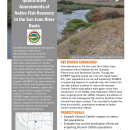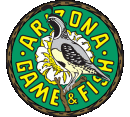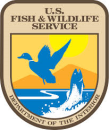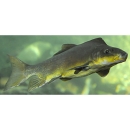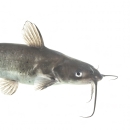Location



















States
Arizona, Colorado, New Mexico, UtahEcosystem
River/streamIntroduction
The San Juan River sub-basin is the second largest of the three sub-basins that comprise the Upper Colorado River Basin. Construction of the Navajo Dam on the San Juan River in 1962, while necessary for water development and flood control in the area, has reduced native fish habitat through flow alterations. Two federally endangered native fishes, the Colorado Pikeminnow (Ptychocheilus lucius)and the Razorback Sucker (Xyrauchen texanus), have decreased in numbers in the river. In addition to habitat loss, scientists believe that non-native fish species such as the Channel Catfish (Ictalurus punctatus) are impeding the recovery of native fish populations through predation and competition for resources.
In 1991, the Animas-La Plata Project biological opinion identified the development and implementation of the San Juan River Basin Recovery Implementation Program (SJRBRIP) as a reasonable and prudent alternative (RPA) to prevent jeopardizing the continued existence of native fish. In 1992, state, federal, and tribal agencies executed a cooperative agreement to launch the SJRBRIP to conserve and recover Colorado Pikeminnow and Razorback Suckers in the San Juan River Basin while meeting water needs of the local communities. The program focused on stocking endangered fish populations, guaranteeing minimum flows and high flows to maintain habitat, building and maintaining fish passages and fish exclusion devices, and mechanically removing nonnative fish (especially Channel Catfish) via electrofishing. However, the benefits of Channel Catfish control for native species conservation and recovery are uncertain -- researchers were unable to distinguish whether changes in endangered fish populations were due to eradication efforts, other management actions, or other natural environmental factors. In 2016 the SJRBRIP implemented a research program to clearly quantify the effects of Channel Catfish on native fish species, assess the efficacy of catfish eradication efforts, and evaluate native fish stocking success.
Key Issues Addressed
Construction of the Navajo Dam on the San Juan River Basin along with the subsequent introduction of the non-native plant Russian olive (Elaeagnus angustifolia) has altered the flow of the river, reducing critical habitats for native species: gravelly river margins, sheltered backwaters, and slow-moving pools. The SJRBRIP has been regularly stocking the river with young Colorado Pikeminnow and Razorback Suckers since the mid 1990s. However, these efforts have not resulted in self-sustaining populations of the endangered fishes and therefore biologists have developed additional research efforts to evaluate what is hindering the species’ recovery.
In addition to habitat degradation and loss, non-native fish can present a hindrance to native fish recovery. Non-native fish may prey on native fish species or outcompete them for resources. Channel Catfish populations have increased since introduction into the San Juan River Basin throughout the early to mid 1900s. Beginning in 1998, biologists from the SJRBRIP prioritized eradicating this species to aid in native fish recovery. A large portion of the program’s resources went to seasonal, large-scale mechanical removal efforts of the non-native fish via electrofishing. However, the large size of the river made this task difficult. Another challenge is that fish populations naturally fluctuate in numbers, making it difficult for biologists to determine the effectiveness of their eradication efforts. Additionally, it is unclear how Channel Catfish actually impact and compete with native fish populations because it has been difficult to assess the extent of direct competition and predation on the native species. This uncertainty fueled the need for scientific, quantitative analyses to better inform future conservation efforts.
Project Goals
- Quantify direct Channel Catfish impacts on native fish populations to inform program leaders on the severity of the threat and the necessity of eradication efforts
- Evaluate how current eradication efforts are impacting Channel Catfish population sizes, and adjust removal strategies if necessary
- Determine what is causing lower than anticipated survival rates of stocked Colorado Pikeminnow and Razorback Sucker in the first three years post-stocking
Project Highlights
Making Progress: Management by the SJRBRIP and other organizations in the Colorado River Basin has benefitted the Razorback Sucker, resulting in a proposal to downlist the species from endangered to threatened.
- Non-Native Aquatics Removal Techniques: The SJRBRIP historically has done annual, large-scale mechanical removal of Channel Catfish using raft-mounted electrofishing. Removal was spread out between March and October of each year. Typically, two rafts would sample perpendicular to the shoreline, with one netter per raft to collect non-native fish encountered. However, the work is labor intensive and hard to implement in large river systems, which prompted the drive for a quantitative evaluation of these efforts.
- Diet Analysis: To gain insight into how Channel Catfish may impact native fish species, researchers quantified rates of native fish consumption by examining fish stomach contents in combination with estimates of population sizes. Fish prey accounted for 6.1% of the average Channel Catfish diet, and the catfish population consumed an estimated 215,000-735,000 native fish per year in the San Juan River Basin, depending on river conditions.
- Removal Rates: Project biologists assessed the effectiveness of mechanical removal efforts of catfish in the San Juan River Basin. While removal efforts reduced the density of non-native fishes, current removal rates using electrofishing will not fully eradicate the Channel Catfish. Removal rates also varied depending on the location in the basin -- in the upper reaches of the river, both juvenile and adult catfish populations declined, while in the lower regions there was no significant decline during the study period.
- Native Fish Survival: Biologists working for the SJRBRIP found that juvenile Colorado Pikeminnow had a 25% lower survival rate compared to wild populations in the Green River, leading to low adult recruitment. One possible reason could be the negative effects of electrofishing and mark-recapture methods on juvenile fish.
Lessons Learned
Using electrofishing as a tool for fish capture and removal is a standard practice. However, the SJRBRIP discovered that the preference for deep benthic habitats of Channel Catfish likely decreased their susceptibility to electrofishing compared to other invasive species invasive species
An invasive species is any plant or animal that has spread or been introduced into a new area where they are, or could, cause harm to the environment, economy, or human, animal, or plant health. Their unwelcome presence can destroy ecosystems and cost millions of dollars.
Learn more about invasive species . Additionally, researchers determined that electrofishing can unintentionally harm native fish, such as the Colorado Pikeminnow. This highlights the importance of carefully evaluating the effectiveness of management plans in the area of interest.
Researchers noted both spatial and temporal challenges in non-native control. Seasonal movement limited the researchers’ ability to assess the effectiveness of removal efforts. In the summer, lower reaches tend to have an increase in catfish despite removal efforts due to their downstream movement after spawning. Because of this, removal efforts in the lower regions of the basin appear to have lower success rates compared to the upper and middle regions. Additionally, immigration and emigration rates across sections of the river are very difficult to assess. It is important to take spatial and temporal variability into account when constructing and evaluating management strategies.
Researchers also noted the importance of considering the life history stages of both native and non-native fish. Data from the catfish diet study showed that larger Pikeminnow were less likely to be preyed upon by catfish. By raising Colorado Pikeminnow in the hatchery for an additional year so that they are larger before being released, consumption by Channel Catfish could be reduced by almost 40%. Larger-sized catfish also consume more native fish -- targeting larger catfish individuals for removal, perhaps during spawning season at known breeding grounds along the river, might enhance native fish recovery.
Next Steps
- Conduct additional studies to further understand the role catfish play in the recovery of native fish: Although researchers confirmed that catfish consume native fish, catfish are sometimes scavengers. It is unknown if native fish were dead or alive when consumed. Additionally, researchers still do not understand the level of competition for food and space between Channel Catfish and native fish.
- Optimize eradication efforts by developing new strategies to increase removal efficiency: The SJRBRIP plans on taking a 3-5 year break from active catfish eradication to instead focus on strategy development and further studies.
- Alter hatchery production by giving stocking fish an extra year in the hatchery while providing enrichment to increase survival: One plan includes subjecting the juvenile fish to increased water flow rates that might better prepare them for actual river conditions when finally stocked.
Funding Partner
Funding for this work was provided through authorizing legislation for the USFWS San Juan River Basin Recovery Implementation Program and was administered by the Bureau of Reclamation
Resources
- Pennock et al. (2018). “Predicted and observed responses of a nonnative Channel Catfish population following managed removal to aid the recovery of endangered fishes.” North American Journal of Fisheries Management 38(3): 565-578.
- Hedden et al. (2020). “Quantifying Consumption of Native Fishes by Nonnative
Channel Catfish in a Desert River.” North American Journal of Fisheries Management 41: S82-S94.
- Franssen et al. (2014). “Fish Community Responses to Mechanical Removal of Nonnative Fishes in a Large Southwestern River.” Fisheries 39(8):352-363.
- Clark et al. (2018). “Age-Specific Estimates Indicate Potential Deleterious Capture Effects and Low Survival of Stocked Juvenile Colorado Pikeminnow.” North American Journal of Fisheries Management 38:1059–1074.
Contacts
- Scott Durst, Science Coordinator, San Juan River Basin Recovery Implementation Program, U.S. Fish and Wildlife Service: scott_durst@fws.gov
- Mark McKinstry, Biological Scientist, Bureau of Reclamation: mmckinstry@usbr.gov
- Sky Hedden, Colorado River Basin Coordinator, Arizona Game and Fish Department: shedden@azgfd.gov
CART Lead Author
Angela Schmitt, CCAST Student Intern, University of Pennsylvania
Suggested Citation
Schmitt, A., McKinstry, M., Durst, S., Hedden, S. (2022). “Quantitative Assessments of Native Fish Recovery in the San Juan River Basin.” CCAST. Retrieved from https://www.fws.gov/project/quantitative-assessments-native-fish-recovery



